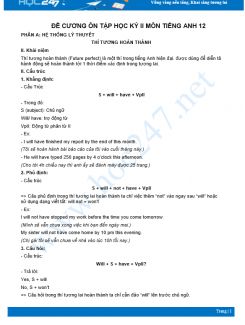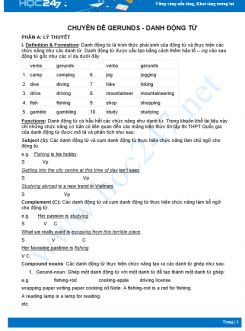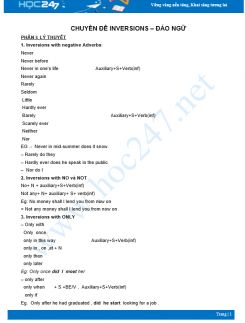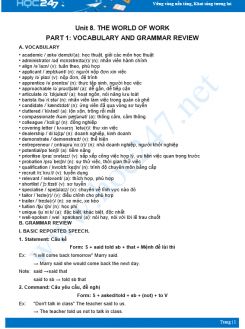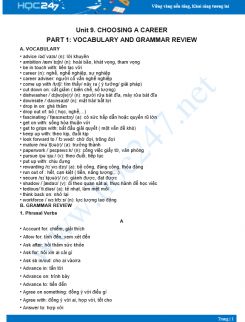Qua nội dung tài liệu Tổng hợp lý thuyết và bài tập các cấu trúc nâng cao trong Tiếng Anh giúp các em học sinh lớp 12 có thêm tài liệu ôn tập rèn luyện kĩ năng làm bài để chuẩn bị cho các kì thi sắp đến được HOC247 biên soạn và tổng hợp đầy đủ. Hi vọng tài liệu sẽ có ích với các em.
Chúc các em có kết quả học tập tốt!
TỔNG HỢP LÝ THUYẾT VÀ BÀI TẬP CÁC CẤU TRÚC NÂNG CAO TRONG TIẾNG ANH
PHẦN A: LÝ THUYẾT
Cấu trúc IT IS SAID THAT trong tiếng anh
I. CÁCH DÙNG CẤU TRÚC IT IS SAID THAT:
- Cấu trúc It is said that là dạng câu tường thuật thường sử dụng để đưa tin về một vấn đề nào đó.
-Thông thường, cấu trúc It is said that.... sử dụng trong các câu bị động.
II. CẤU TRÚC IT IS SAID THAT.... TRONG CÂU BỊ ĐỘNG:
Trong câu chủ động: S1 + say + that + S2 + V2 + …
Trong câu bị động: It is said that + S2 + V2 + …
Ex: People say that John is the most intelligent student in his class.
(Mọi người nói rằng John là học sinh thông minh nhất trong lớp của anh ấy).
➔ It is said that John is the most intelligent student in his class.
(Nó được nói rằng John là học sinh thông minh nhất trong lớp của anh ấy).
Notes:
– Khi chuyển từ câu chủ động sang câu bị động cần chú ý động từ Say chia ở thì nào thì chia động từ Tobe của cấu trúc It is said that ở thì động từ đó.
– Từ said trong cấu trúc It is said that có thể thay thế bằng các từ thought (nghĩ), believed (tin tưởng), supposed (cho là), reported (báo cáo, tường thuật), expected (mong đợi), known (biết), considered (xem xét).
III. CÁCH BIẾN ĐỔI KHÁC CỦA CẤU TRÚC IT IS SAID THAT:
It is said that + S1 + V1 + …
➔ S1 + (tobe) + said + to Vinf… (Khi V1 cùng thì với tobe)
➔ S1 + (tobe) + said + to have Ved/PII +… (Khi V1 khác thì với tobe)
Ex:
1. It is said that my grandfather is 100 years old.
(Nó được nói rằng ông của tôi 100 tuổi).
➔ My grandfather is said to be 100 years old.
(Ông của tôi được nói rằng được 100 tuổi).
2. It is said that they built this house 5 years ago.
(Nó được nói rằng họ đã xây ngôi nhà này 5 năm trước).
➔ They are said to have built this house 5 years ago.
(Họ được nói đã xây ngôi nhà này 5 năm trước).
Cấu trúc HARDLY
Hardly: vừa mới, hầu như không
Trạng từ phủ định Hardly có nghĩa là có vẻ như, hầu như.
I. Cách dùng Hardly
Hardly thường có một số nghĩa sau:
– Hardly bản thân từ này mang nghĩa tiêu cực, chỉ một cái gì đó ở mức độ vừa đủ.
– Hardly diễn tả những sự việc, hành động mới bắt đầu, diễn ra.
– Hardly được dùng để diễn tả sự việc khó có thể thừa nhận.
– Hardly thường kết hợp cùng một số từ như any, ever, at all hoặc có thể là can, could.
Ex: She hardly ever go out at night.
(Cô ấy hầu như ra ngoài vào buổi tối).
II. Vị trí Hardly trong Tiếng Anh
Trong câu, Hardly thường có các vị trí khác nhau như sau:
– Hardly có vị trí đứng ở đầu câu với vai trò một trạng từ.
– Hardly đứng ở giữa câu sau chủ ngữ và động từ chính.
– Hardly cũng có thể có vị trí ở cuối câu.
III. Cấu trúc Hardly
Cấu trúc 1: Hardly + N/Adj…
Ex: A thing is hardly bigger than my face.
(Có một thứ có vẻ như to hơn mặt của tôi).
Cấu trúc 2: Cấu trúc Hardly trong câu đảo ngữ.
a. Hardly trong câu đảo ngữ thông thường.
Hardly + trợ động từ + S + Vinf…
Ex: I hardly go to school late. (Tôi hầu như không đến trường muộn).
➔ Hardly do I go to school late. (Tôi hầu như không đến trường muộn).
b. Hardly trong câu đảo ngữ có when. (Hardly … when)
Hardly + had + Ved/PII + when + S + VQKĐ…
➔ No sooner had + Ved/PII + than + S + VQKĐ…
Ex: Hardly had I left my house when it rained.
(Hầu như tôi về nhà khi trời mưa).
➔ No sooner had I left my house than it rained.
(Không sớm hơn khi tôi về nhà thì trời mưa).
*Note: Cấu trúc đảo ngữ trên có thể dùng trong các bài tập viết lại câu.
* Một số từ có cách dùng như Hardly:
Scarely: hiếm khi, hầu như không, chắc không
Barely: vừa đủ
Ex: – They were scarely thirty people here.
(Chắc không có tới 30 người ở đây).
- Jun can barely see them.
(Vừa đủ Jun có thể gặp chúng).
➔ Các từ Hardly, Scarely, Barely có thể dùng thay thế nhau trong các câu Tiếng Anh.
Cấu trúc Not only…But also
1. Not only…But also là gì ?
Not only…but also: Không những/không chỉ … mà còn. Dùng trong một câu nói có mà có hai tính chất.
2. Các dạng cấu trúc not only... but also
Dạng 1: Danh từ (Noun)
S + V + not only + Noun + but also + Noun
Ví dụ:
Mai has not only pens but also pencils. (Mai không chỉ có bút mực mà còn có cả bút chì.)
Dạng 2: Tính từ (Adjective)
S + V + not only + Adj + but also + Adj
Ví dụ:
Peter is not only handsome but also intelligent. (Peter không chỉ đẹp trai mà còn thông minh.)
Dạng 3: Trạng từ (Adverb)
S + V + not only + Adv + but also + Adv
Ví dụ:
He worked not only hard but also effectively. (Anh ta làm việc không những chăm chỉ mà còn rất hiệu quả.)
Dạng 4: Cụm giới từ (Prepositional phrase)
S + V + not only + Prep + but also + Prep
Ví dụ:
Doing exercise is not only good for your physical health but also for mental health. (Tập thể dục không những tốt cho tình trạng thể chất mà còn tốt cho tinh thần.)
Dạng 5: Động từ (Adjective)
S + not only + V + but also + V
Ví dụ:
Bob not only studies well but also draws well. (Bob không những học giỏi mà còn vẽ đẹp.)
Dạng 6: Đảo ngữ Not only…But also
Chúng ta cũng có thể dùng Not only…But aslo với dạng đảo ngữ khi cần nhấn mạnh ý muốn diễn đạt:
Not only + Trợ động từ + Chủ ngữ + Động từ + but also + Chủ ngữ + Động từ
Ví dụ: Not only does he sing very well but aslo he plays guitar professtionally.
NOT ONLY children but grown up people also love Tom and Jerry cartoons.
NOT ONLY children but (also) grown up people love Tom and Jerry cartoons.
Nối 2 mệnh đề:
Ex: English helps me not only get a good job, but it aslo helps me to connect with people around the world.
Cấu trúc NOT UNTIL ... ONLY WHEN
Chú ý: Not until và Only when có ngữ nghĩa gần giống nhau, đôi khi có thể thay thế nhau
I. Cấu trúc Not Until
Not until …. : Mãi đến khi, cho đến khi
Not until S + auxiliary verb……auxiliary verb + S
Vế 1 Vế 2 (đảo trợ động từ hoặc tobe lên trước)
Như vậy vế 1 viết như thông thường, vế 2 đảo ngữ là chúng ta đã có một câu đúng ngữ pháp.
Ví dụ:
Not until [we had reached the top] [did we realize how far we had come].
=> Mãi đến khi lên tới đỉnh, chúng tôi mới nhận ra mình đã đi được bao xa.
II. Cách viết lại câu với Not until
We couldn’t see the view of the ocean until the rain stopped.
=> Not until [the rain stopped][could we see the view of the ocean].
Cách viết lại câu:
+ Giữ nguyên vế sau until và đặt ngay sau Not until
+ Vế còn lại chuyển thành khẳng định vào đảo trợ động từ lên trước chủ ngữ
Ví dụ:
1. The protests didn’t stop until the president resigned.
=> Not until [the president resigned][did the protests stop]
Dịch: Mãi đến khi tổng thống từ chức, các cuộc biểu tình mới dừng lại.
2. I didn’t stop worrying about my daughter until she call me.
=> Not until [my daughter called me][did I stop worrying about her].
Dịch: Mãi đến khi em gái gọi điện cho tôi, tôi mới ngừng lo lắng về cô ấy.
III. Cấu trúc Only when
Only when…: Chỉ đến khi
Cấu trúc và cách dùng của Only when giống y hệt với Not until
Ví dụ Only when:
1. Only when I filled my glass did I notice that it was broken.
I didn’t notice that my glass was broken until I filled it.
=> Only when I filled my glass did I notice that it was broken.
Dịch: Chỉ đến khi tôi đổ đầy cốc nước, tôi mới nhận ra rằng nó bị vỡ.
2. He didn’t visit me until he needed some money.
=> Only when he needed some money did he visit me.
Dịch: Chỉ đến khi anh ta cần tiền, anh ta mới đến thăm tôi.
CẤU TRÚC: NO SOONER ... THAN
No sooner … than: Vừa mới làm gì thì đã làm gì; Ngay khi…
I. Cách dùng No sooner…than.
– Cấu trúc No sooner…than thường dùng ở thì quá khứ hoàn thành và thì quá khứ đơn.
– Cấu trúc No sooner…than dùng để nhấn mạnh mệnh đề chính trong câu.
– No sooner…than dùng để diễn tả một điều gì đó sẽ xảy ra ngay lập tức.
– No sooner…than trong câu đảo ngữ với cách nói chuyện lịch sự.
– Trong câu, No sooner…than có vị trí đứng đầu mệnh đề chính.
II. Cấu trúc No sooner…than.
1. Các cấu trúc thông dụng của No sooner…than.
No sooner + TĐT (Auxiliary) + S + V… + than + S + V…
Ex: No sooner had I gone out than the phone rang.
(Tôi vừa ra ngoài thì điện thoại đổ chuông).
2. Viết lại câu với cấu trúc No sooner…than.
No sooner + TĐT (Auxiliary) + S + V… + than + S + V…
➔ Harly + TĐT (Auxiliary) + S + V… + when + S + V…
Hardly có thể thay thế bằng các từ như Scarcely (vừa mới), Seldom (hiếm khi), Never (không bao giờ), Barely (chỉ mới), Little (Ít khi), Rarely (hiếm khi).
Ex: No sooner had they arrived at the market than the announcement started.
(Họ vừa mới đến siêu thị thì đã có thông báo).
➔ Hardly had they arrived at the market when the announcement started.
( Hầu như họ đến siêu thị khi đã có thông báo).
Note: No sooner bắt buộc phải đi cùng với than.
PHẦN B: BÀI TẬP VẬN DỤNG
I. BÀI TẬP VẬN DỤNG CẤU TRÚC IT IS SAID THAT:
Exercise 1:
1. People say that his family has a lot of money in his house.
➔ It is said that _________________________________.
➔ His family is said ______________________________.
2. People say that the train leaves at 12 a.m.
➔ It is said that _____________________.
➔ The train is said ___________________.
3. People say that Wind passed the exam last week.
➔ It is said that __________________________.
➔ Wind is said __________________________.
4. People say that we have eaten Korea’s food for 2 months.
➔ It is said that _________________________________.
➔ We are said __________________________________.
5. People say that Jun is a handsome boy.
➔ It is said that __________________.
➔ Jun is said ____________________.
ĐÁP ÁN
1. ➔ It is said that his family has a lot of money in his house.
➔ His family is said to have a lot of money in his house. (cùng thì)
2. ➔ It is said that the train leaves at 12 a.m.
➔ The train is said to leave at 12 a.m. (cùng thì)
3. ➔ It is said that Wind passed the exam last week.
➔ Wind is said to have passed the exam last week. (khác thì)
4. ➔ It is said that we have eaten Korea’s food for 2 months.
➔ We are said to have eaten Korea’s food for 2 months.
(khác thì nhưng chỉ dùng 1 lần have)
5. ➔ It is said that Jun is a handsome boy.
➔ Jun is said to be a handsome boy. (cùng thì)
Exercise 2:
1. People think that the new prime minister is a good speaker.
➔ It is ___________________________________
➔ The new prime minister __________________
2) They report that the suspended gunman is in custody.
➔ The suspended _________________________
➔ It is __________________________________
3) People don't expect that the new party will win the election.
➔ It isn't ________________________________
➔ The new ______________________________
4) The police say that the principal is at large.
➔ It is _________________________________
➔ The principal _________________________
5) The detective knows that the robber has left the city.
➔ It is _________________________________
➔ The robber ___________________________
6) People believe that giving encouragement is important at work, too.
➔ It is ___________________________________
➔ Giving encouragement ____________________
7) They told us that Charles drank too much at the party.
➔ It was _________________________________
➔ Charles ________________________________
ĐÁP ÁN
1. ➔ It is thought that the new prime minister is a good speaker
➔ The new prime minister is thought to be a good speaker
2. ➔ The suspended gunman is reported to be in custody.
➔ It is reported that the suspended gunman is in custody.
3. ➔ It isn't expected that the new party will win the election.
➔ The new party isn't expected to win the election.
4. ➔ It is said that the principal is at large.
➔ The principal is said to be at large.
5. ➔ It is known that the robber has left the city.
➔ The robber is known to have left the city.
6. ➔ It is believed that giving encouragement is important at work, too.
➔ Giving encouragement is believed to be important at work, too.
7. ➔ It was told that Charles drank too much at the party.
➔ Charles was told to have drunk too much at the party.
Exercise 3:
1. It is said that the thief stole several wallets.
The thief ________________________________________
2. The Sun was believed to move round the Earth.
It was __________________________________________
3. The witness was thought to have injured.
It was __________________________________________
4. They believe that the lunch will be delicious.
The lunch is _____________________________________
5. The newspapers reported that he won the jackpot.
He was ________________________________________
ĐÁP ÁN
1. The thief is said to have stolen several wallets.
2. It was believed that the Sun moves round the Earth.
3. It was thought that the witness injured.
4. The lunch is believed to be delicious.
5. He was reported to have won the jackpot.
II. BÀI TẬP VẬN DỤNG CẤU TRÚC HARDLY
1. The rule work ______. (Hardly/ Scarely/ Barely)
2. There are _______ any new features in that software. (Hardly/ Scarely/ Barely)
3. They could _______ believe us. (Hardly/ Scarely/ Barely)
4. You sold ______ any pens. (Hardly/ Scarely/ Barely)
5. Nam can ________ except me to lend him money again. (Hardly/ Scarely/ Barely).
6. Ha _______ ever goes to bed before 12 p.m. (Hardly/ Scarely/ Barely)
7. ______ Had Viet left his house when his parents came back. (Hardly/ Scarely/ Barely)
ĐÁP ÁN
1. Hardly (có thể dùng cả 3)
2. Hardly
3. Scarely
4. Hardly
5. Hardly (có thể dùng Scarely)
6. Hardly
7. Hardly
III. BÀI TẬP VẬN DỤNG CẤU TRÚC NOT ONLY ... BUT ALSO
Rewrite the following sentences by using the conjunction “not only…but also”:
1. Nam’s handsome. Nam’s intelligent.
.......................................................................................................................
2. Mai plays the guitar well. Mai dances beautifully.
.....................................................................................................................
3. They came late. They left early.
................................................................................................................................
4. She’s tired. She’s hungry.
.........................................................................................................................
5. She can enjoy a good meal and she can go fishing on the lake.
....................................................................................................................
6. They ate lamb chops and fish.
.........................................................................................................................
7. The underground is quick and cheap.
.........................................................................................................................
8. Mr. Brown has read a novel by Charles Dickens and he has seen the film made from it.
.........................................................................................................................
9. They like field events and they like team games.
........................................................................................................................
10. Mary has both toothache and headache.
.......................................................................................................................
11. The pavements are both narrow and crowded.
........................................................................................................................
12. That boy was dirty and he was lazy, too.
.........................................................................................................................
13. Mrs. Brown’s daughter is both beautiful and clever.
.........................................................................................................................
14. He’s betrayed your trust. He’s betrayed your love for him.
.........................................................................................................................
15. She will have to study hard. She will have to concentrate to do well on the exam.
.........................................................................................................................
16. Pneumonia is a dangerous disease. Smallpox is a dangerous illness.
.........................................................................................................................
17. She carried me in her arms and she lulled me to study.
.........................................................................................................................
18. The underground is quick. It is also cheap.
.........................................................................................................................
19. Mary has both toothache and headache.
.........................................................................................................................
20. The thief stole my money. He also tore up my identify card.
.........................................................................................................................
ĐÁP ÁN
1. Nam is not only handsome but also intelligent.
2. Mai not only plays the guitar well but also dances beautifully.
3. They not only came late but also left early.
4. She’s not only tired but also hungry.
5. She can not only enjoy a good meal but also go fishing on the lake.
6. They ate not only lamb chops but also fish.
7. The underground is not only quick but also cheap.
8. Mr. Brown has not only read a novel by Charles Dickens but also seen the film made from it.
9. They like not only field events but also team games.
10. Mary has not only toothache but also headache.
11. The pavements are not only narrow but also crowded.
12. That boy was not only dirty but also lazy.
13. Mrs. Brown’s daughter is not only beautiful but also clever.
14. He’s betrayed not only your trust but also your love for him.
15. She will have to not only study hard but also concentrate to do well on the exam.
16. Not only pneumonia but also Smallpox is a dangerous illness.
17. She not only carried me in her arms but also lulled me to study.
18. The underground is not only quick but also cheap.
19. Mary has not only toothache but also headache.
20. The thief not only stole my money but also tore up my identify card.
III. BÀI TẬP VẬN DỤNG CẤU TRÚC NO SOONER ... THAN ...
1. No sooner had she entered the class than my teacher noticed us.
➔ ________________________________________________. (Hardly)
2. No sooner had Lan and her parents came back than the rain started.
➔ _________________________________________________. (Hardly)
3. Hardly had the movie started when we came.
➔ _________________________________________________. (than)
4. Hardly had my teacher come when we left school.
➔ _________________________________________________. (than)
5. Rarely had I closed this door when my best friends knocked.
➔ ______________________________________________. (than)
6. Hardly had Tom come home when the troubles happened.
➔ ____________________________________________. (than)
7. Never had Lim left home when we went back.
➔ __________________________________. (than)
ĐÁP ÁN
1. Hardly had she entered the class when my teacher noticed us.
2. Hardly had Lan and her parents come back when the rain started.
3. No sooner had the movie started than we came.
4. No sooner had my teacher came than we left school.
5. No sooner had I closed this door than my best friends knocked.
6. No sooner had Tom come home than the troubles happened.
7. No sooner had Lim left home than we went back.
--(Nội dung đầy đủ, chi tiết vui lòng xem tại online hoặc đăng nhập để tải về máy)---
Trên đây là một phần trích đoạn nội dung Tổng hợp lý thuyết và bài tập các cấu trúc nâng cao trong Tiếng Anh. Để xem thêm nhiều tài liệu tham khảo hữu ích khác các em chọn chức năng xem online hoặc đăng nhập vào trang hoc247.net để tải tài liệu về máy tính.
Hy vọng tài liệu này sẽ giúp các em học sinh ôn tập tốt và đạt thành tích cao trong học tập.
Mời các em tham khảo các tài liệu có liên quan:
- Vocabulary and Grammar Revision for Unit 7, 8 Tiếng Anh 12
- Vocabulary and Grammar Revision for Unit 8 Tiếng Anh 12
- Vocabulary and Grammar Revision for Unit 9 Tiếng Anh 12
Chúc các em học tập tốt!







